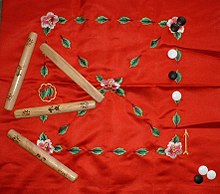Yunnori
| Yut | |

A game of yut with the sticks cast as a do
|
|
| Korean name | |
|---|---|
| Hangul | 윷 / 윷놀이 |
| Revised Romanization | Yut / Yunnori |
| McCune–Reischauer | Yut / Yunnori |
Yut Nori, also known as Yunnori, Nyout, and Yoot, is a traditional board game played in Korea, especially during Korean New Year. The game is also called cheok-sa or sa-hee. The combining-form -nori means 'game'.
Although the origins of this popular family game are unclear, some research suggests that yut was played as early as the Three Kingdoms (57 BCE – 668 CE). The Taiping Imperial Reader states that people of Baekje played a board game similar to Chupu, which is believed to be similar to Pachisi, a board game originating in India.
There is a folk explanation for the game, describing a bet by some villagers to raise five different kind of livestock: pigs, dogs, sheep, cows and horses. Each of the villagers would raise only one type.
The board and the game are known to have been used in fortune-telling, particularly in mountain-areas and small farming-villages, but this is no longer practiced.
The board (mal-pan, 말판) is normally made of stitched cloth. The modern board is a rectangular shape, but historically there was also a round variation. There are four straight courses and two diagonal ones. Each of the straight courses comes with five stations, the diagonal ones have five stations, too, but one is shared. This brings the number of stations to twenty-nine in total. The board is also known to sometimes be drawn onto the floor.
Instead of dice, yut-sticks are used. (These are similar to those used in the Egyptian board game Senet.) There are two kinds of yut-stick: jang-jak yut (장작 윷) and bam yut (밤 윷). Jang-jak yut are made of firewood. There are four sticks of about 15 cm in length and from 2 cm to 3 cm. in diameter. These sticks are split into halves. Chestnut-wood is most commonly used, but birch-wood is also common. These woods are chosen for their weight and the fresh sound they make when playing. Bam yut, on the other hand, are wooden sticks of about 3 cm in length. They have a diameter of about 1 cm, and also are split into halves. The bam yut are played in a small bowl, shaken in the palm, and then released.
...
Wikipedia
